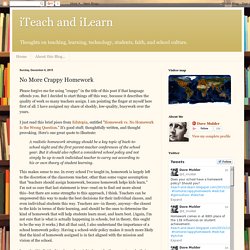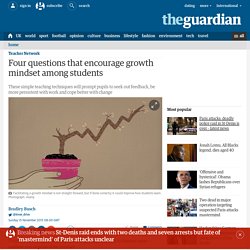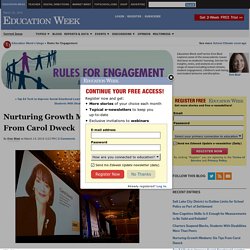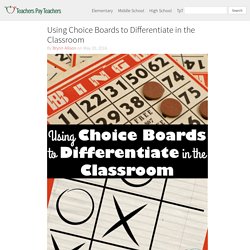

Mindfulness in the Classroom. Growth Mindset: Moving From I Can't To I Can't Yet. This is the first in Marion Ivey’s Getting Better Together series, Moving From I Can’t To I Can’t Yet.

Marion and all the Teaching Channel Laureates are going public with their practice and seeking support in getting better from colleagues and the Tch community. Last year, on the first day of school, I asked my kindergarteners to draw self-portraits. I passed out hand mirrors to each child and said, “Draw yourself the way you look today.” One little girl looked at me, batted her long lashes, and said, “I can’t.” Four Strategies To Create A Culture of Success in Middle School. If you’ve ever taught middle school, you know it can be challenging.

But you also know what a special place being in the middle can be. Middle schoolers enjoy laughter. iTeach and iLearn: No More Crappy Homework. Please forgive me for using "crappy" in the title of this post if that language offends you.

But I decided to start things off this way, because it describes the quality of work so many teachers assign. I am pointing the finger at myself here first of all. I have assigned my share of shoddy, low-quality, busywork over the years. I just read this brief piece from Edutopia, entitled "Homework vs. No Homework Is the Wrong Question. " A realistic homework strategy should be a key topic of back-to-school night and the first parent-teacher conferences of the school year. This makes sense to me. 13 Strategies to Improve Student Classroom Discussions. Questions inspire!

When educators pose thought-provoking questions to their students, they send a powerful message that students’ ideas about what they read are valuable. Great Books' professional learning courses, webinars and consultation days help educators gain new instructional strategies, pose higher-order and text-dependent questions, and encourage classroom discussion. Asking the right questions at the right time is a skill best cultivated over time. Educators who learn the art of effective questioning help their students develop the capacity to think critically, to analyze and comprehend challenging texts, to listen carefully to new perspectives, and to communicate complex ideas both orally and in writing. To learn more about our professional learning courses, webinars and consultation days, please visit us online. The Great Books Foundation also offers a wide range of fiction and nonfiction materials that give your students the skills they need to be college and career ready.
Four questions that encourage growth mindset among students. Teachers have long battled with how to get their students to become more resilient and improve their mindset.

One popular theory, pioneered by Carol Dweck, professor of psychology at Stanford University, is the idea of growth mindset. Nurturing Growth Mindsets: Six Tips From Carol Dweck - Rules for Engagement. Washington Stanford researcher Carol Dweck clearly tapped into a powerful and compelling idea when she linked the concept of growth mindsets to academic success.

As fans of Dweck's research can quickly explain, people with fixed mindsets see strengths and skills as inate traits, like eye color. You're either born with them, or you're not. But people with growth mindsets recognize that the brain can grow and change through effort, and they embrace failures as opportunities for developing new strategies and approaches to learning content and concepts they find challenging. Enthusiasm for Dweck's work has spread rapidly, and her name is a buzzword in many schools as teachers buy into the idea that helping students shift their mindsets can lead to academic gains. Using Choice Boards to Differentiate in the Classroom.
As I grew more experienced in the classroom, I also grew more comfortable with students making choices and working independently.

As the teacher, I didn’t have to have the control all of the time. When I did relax a little bit and hand some of that control over to my students, I realized I was also increasing the level of responsibility students had for completing their own work. When all of my students were doing the same thing at the same time, it required very little effort on the students’ part. Giving them choices meant now they had options, but they had to do the work individually rather than relying on the teacher or other classmates.
One of my favorite ways to give students choices is using choice boards. Choice Boards: The Basics A choice board is just what it sounds like: A board of choices. The formatting and directions for choice boards are also flexible. For this type of choice board, I assign a certain number of choices per column. Using Choice Boards to Culminate a Unit. De Bono's Hats. Resources for Teaching Growth Mindset. Empowering Students Through Multimedia Storytelling. Bloom's Digital Taxonomy Verbs [Infographic] When using Bloom’s Digital Taxonomy (a revised take on Bloom’s devised by educator Andrew Churches), it helps to have a list of verbs to know what actions define each stage of the taxonomy.
This is useful for lesson planning, rubric making, and any other teacher-oriented task requiring planning and assessment strategies. The Bloom’s Digital Taxonomy verbs in this handy infographic apply specifically to each stage of the taxonomy. They progress from LOTS (lower-order thinking skills) to the HOTS (higher-order thinking skills). According to Churches on his wiki Edorigami, “Bloom’s Revised Taxonomy describes many traditional classroom practices, behaviours and actions, but does not account for the new processes and actions associated with Web 2.0 technologies …” This means the verbs listed below are applicable to facilitating technology use in the modern classrooms.
A Quick Reference Tool for Bloom’s Taxonomy Verbs Poster Files For You. 22 Powerful Closure Activities. Too many university supervisors and administrators criticize the absence of lesson closure, a dubious assessment practice likely caused by the improper use of Madeline Hunter’s lesson plan model (PDF) as a de facto checklist of eight mandatory teaching practices -- anticipatory set, objective and purpose, input, modeling, checking for understanding, guided practice, independent practice, and closure -- a custom that Hunter decried in 1985 (PDF).

Although it offers multiple benefits, please don't view closure as a professional must-do. What Is Closure? Closure is the activity that ends a lesson and creates a lasting impression, a phenomenon that Colorado State University professor Rod Lucero calls the recency effect. Teachers use closure to: Teaching Tools.